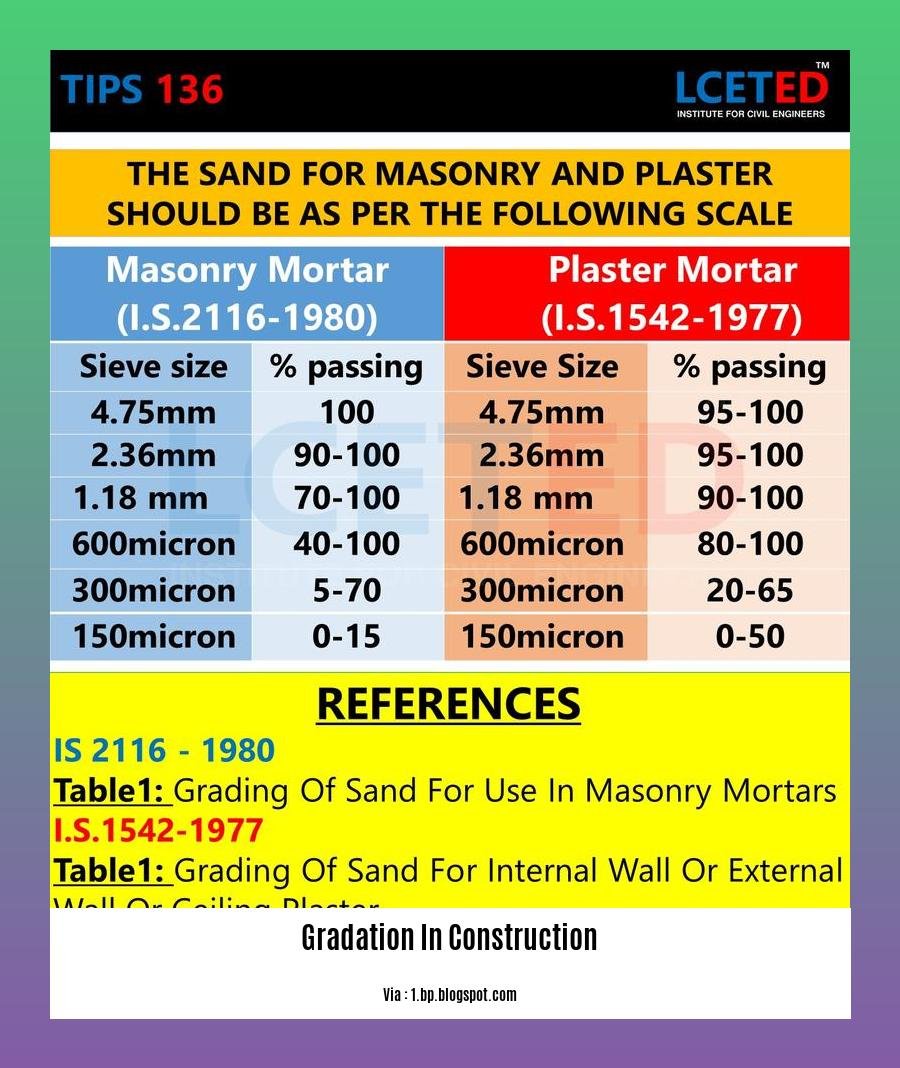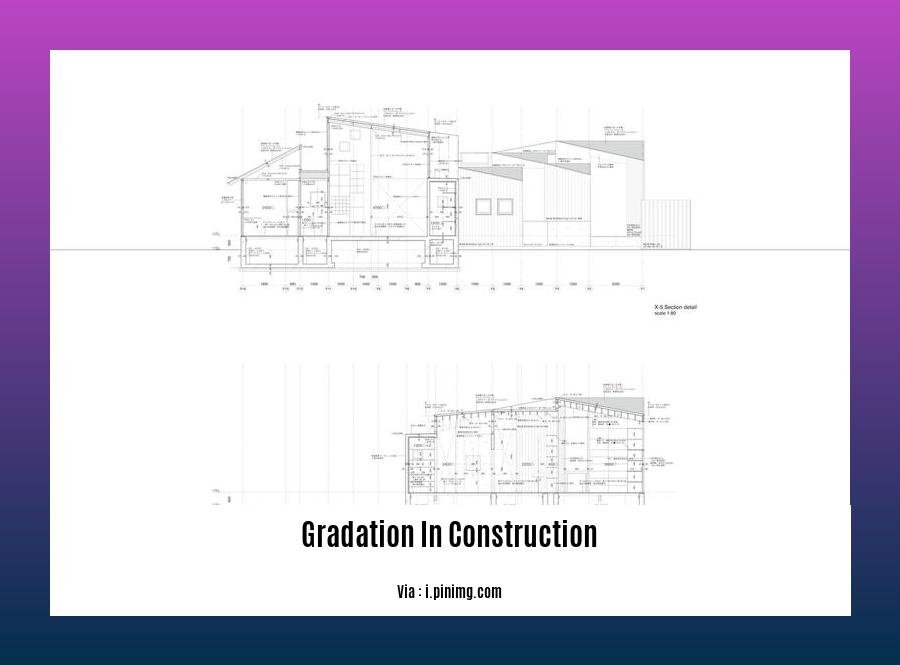Delve into the intricacies of gradation in construction with our comprehensive guide, [- Unlocking the Secrets of Gradation in Construction:]. Embark on a journey through the principles, techniques, and significance of proper site preparation and foundation stability. Discover how precise elevation control, drainage system design, and material selection impact project outcomes and meet industry standards. Join us as we unveil the secrets of gradation, empowering you to achieve optimal results in your construction endeavors.
Key Takeaways:
- Gradation: Arranging aggregates by size for stronger concrete mixes.
- Grading: Creating level or sloped surfaces by adding/removing soil for drainage and stability.
- Gradation and grading are crucial for building strength and ensuring construction sites are even, well-drained, and stable.
Gradation in Construction: Defining the Foundation

Gradation in construction is akin to a symphony, where different-sized aggregates dance together, each contributing to the overall harmony of the structure. It’s the art of manipulating particle sizes in sand, gravel, and crushed stone to create mixes that are strong, durable, and drain flawlessly.
The Importance of Gradation
Optimizing Concrete Strength: Particle size and distribution directly impact concrete’s strength. A well-graded mix ensures a tight-knit structure, minimizing voids and maximizing load-bearing capacity.
Ensuring Proper Drainage: Gradation controls the flow of water through construction materials. A well-graded base allows water to percolate freely, preventing ponding and structural damage.
Grading for Stability
Grading is the process of precisely leveling or sloping a site to provide a stable foundation for construction. It involves adding or removing soil, carefully controlling elevation to prevent erosion and ensure proper drainage.
Key Steps in Grading
- Site Assessment: Determine soil conditions, site topography, and drainage needs.
- Grading Plan: Design a grading plan that meets project requirements, including elevation control and drainage.
- Excavation and Fill: Remove excess soil or add fill to achieve the desired slope or elevation.
- Compaction: Compact the soil to increase its density and stability.
- Finishing: Grade the surface to ensure smooth transitions, prevent erosion, and facilitate drainage.
Gradation and Grading Techniques
- Mechanical Grading: Using heavy machinery (e.g., bulldozers, graders) to move and shape soil.
- Manual Grading: Using hand tools (e.g., shovels, rakes) for small-scale grading or fine-tuning.
- Laser Grading: Utilizes lasers to guide automated grading equipment, ensuring precise elevation control.
Conclusion
Gradation in construction is a fundamental process that ensures the integrity and longevity of any structure. By skillfully manipulating particle sizes and grading the site, we create stable foundations and optimize the performance of concrete and drainage systems. Embracing these principles is crucial for building environments that stand the test of time.
Discover the transformative power of buffing in construction, a technique that enhances surfaces, improves durability, and imparts a gleaming finish.
Unravel the enigma of GRC full form in construction, a versatile material that combines strength, durability, and aesthetic appeal.
Delve into the GRC meaning in construction, exploring its applications, benefits, and the innovative ways it shapes modern structures.
Techniques for Soil Preparation and Compaction

Soil preparation and compaction are foundational steps that ensure the stability and longevity of any construction project. By manipulating soil properties and using proven techniques, we set the stage for successful building outcomes.
Key Takeaways:
- Soil compaction increases density, providing stability and preventing failures.
- Soil type, moisture content, and compaction effort greatly influence outcomes.
- Proper preparation and compaction create a solid foundation for construction projects.
Steps for Soil Preparation:
- Site Assessment: Evaluate soil composition, drainage patterns, and any existing structures.
- Soil Amendments: Add organic matter or other amendments to improve soil quality and drainage.
- Leveling and Grading: Use heavy equipment to level the site and establish proper drainage.
- Compaction: Use compaction equipment to increase soil density and create a firm foundation.
Techniques for Soil Compaction:
- Dynamic Compaction: Uses heavy equipment to apply impact forces to the soil.
- Vibratory Compaction: Utilizes vibrating plates or rollers to densify the soil.
- Static Compaction: Applies steady pressure to the soil using rollers or other equipment.
Pros and Cons of Compaction Techniques:
| Technique | Pros | Cons |
|---|---|---|
| Dynamic Compaction | High compaction efficiency | Can cause surface damage |
| Vibratory Compaction | Uniform compaction | May not penetrate deep soils |
| Static Compaction | Gradual, controlled compaction | Slower process |
By understanding these techniques and applying them skillfully, we can transform loose soil into a stable and reliable base for our building endeavors.
Citations:
- Soil Compaction Handbook – Multiquip Inc.
- Soil Compaction On Construction Sites – ResearchGate
Common Pitfalls and Challenges in Gradation
From assessing the site’s topography to selecting the right materials, gradation plays a crucial role in construction. But even with meticulous planning, unforeseen challenges and pitfalls can arise. Understanding these obstacles is key to avoiding costly mistakes.
Key Takeaways:
- Underestimating Drainage Needs: Inadequate drainage systems can lead to water pooling, erosion, and structural damage.
- Ignoring Soil Conditions: Failing to account for soil type and moisture content can result in uneven settling, cracking, and instability.
- Poor Site Supervision: Lack of oversight can lead to deviations from the grading plan, compromising project outcomes.
Pitfalls in Gradation:
1. Drainage Woes:
– Insufficient slopes and improper drainage channels can trap water, causing flooding and waterlogging.
– Incorrect grading can direct water towards foundations, damaging structures.
2. Fickle Foundations:
– Overlooking soil properties and compaction can lead to unstable foundations.
– Varying soil conditions can create uneven settling, compromising structural integrity.
3. Supervision Slip-Ups:
– Inadequate supervision can result in deviations from the grading plan.
– Poor communication can lead to misunderstandings and errors in execution.
Overcoming Challenges:
- Thorough Site Evaluation: Conduct a detailed assessment of the site’s topography and soil conditions to plan drainage and grading strategies accordingly.
- Materials Match-Up: Select materials that are compatible with the soil and project requirements, ensuring stability and drainage.
- Diligent Supervision: Monitor the grading process closely to ensure adherence to the plan and address any issues promptly.
URL Sources:
- Site Grading Design (A Guide for the Non-Professional)
- Grading in Construction: Everything You Need To Know
Best Practices for Quality Control and Inspection
In construction, ensuring the highest standards of quality is paramount. Implementing robust Best Practices for Quality Control and Inspection is the cornerstone of achieving this goal. These practices empower construction professionals to identify and rectify potential issues proactively, minimizing the risk of defects and ensuring the longevity of the built environment.
Key Takeaways:
- Establish Clear Inspection Plans: Define the scope of inspections, inspection frequency, and accountability for each construction phase.
- Effective Communication: Ensure timely and transparent communication among project stakeholders to facilitate seamless coordination and address issues swiftly.
- Continuous Improvement: Foster a culture of continuous improvement by providing regular feedback to inspectors and implementing lessons learned from past inspections.
Steps for Effective Inspections:
- Thorough Planning: Develop a comprehensive inspection plan that outlines the inspection schedule, responsibilities, and documentation procedures.
- Detailed Documentation: Utilize checklists and inspection reports to capture findings and provide evidence of inspection activities.
- Independent Verification: Engage independent inspectors to provide an unbiased assessment of the construction quality and compliance with industry standards.
- Swift Corrective Actions: Implement corrective actions promptly to address identified deficiencies and prevent potential problems from escalating.
- Regular Training: Provide ongoing training to inspectors to enhance their skills and knowledge of the latest industry practices.
Benefits of Rigorous Inspection Practices:
- Enhanced Quality Assurance: Ensures that construction projects meet the specified standards and design requirements.
- Reduced Risk of Failures: Proactive identification and correction of defects minimize the likelihood of structural or safety issues.
- Increased Client Satisfaction: Delivers high-quality projects that meet or exceed client expectations.
Conclusion
Adhering to Best Practices for Quality Control and Inspection is essential for delivering safe, reliable, and enduring construction projects. By following these principles, construction professionals can safeguard the integrity of their work, protect the public interest, and build a better future for the industry.
Relevant URL Sources:
- Quality Control & Inspection in Construction
- Best Practices for Quality Control in Construction
FAQ
Q1. What is the significance of gradation in construction, and how does it impact project outcomes?
Q2. What are the key considerations when performing grading activities on a construction site?
Q3. How can soil compaction techniques enhance the stability of construction sites?
Q4. What are some common pitfalls to avoid during construction grading, and how can they be mitigated?
Q5. What role does effective quality control play in ensuring optimal grading outcomes during construction?
- Does 100% Polyester Shrink? A Complete Guide to Washing & Drying - April 16, 2025
- Elegant Drapery Solutions for Arched Windows: A Complete Guide - April 16, 2025
- The Best Dining Room Tables with Drop Leaves: A Buyer’s Guide - April 16, 2025










